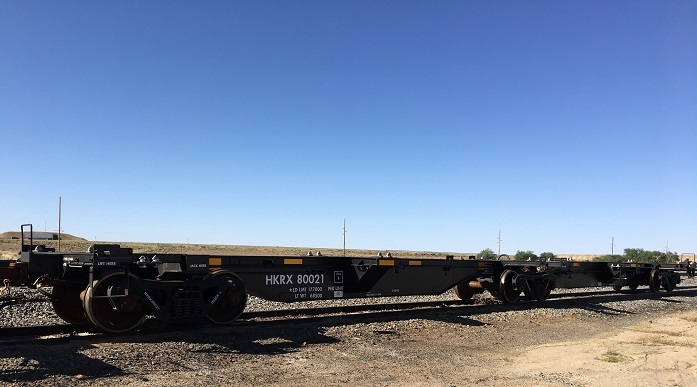 One of three articulated railcars recently added to the Moab Uranium Mill Tailings Remedial Action Project. Each railcar can hold four intermodal containers.
MOAB, Utah – EM’s Moab Uranium Mill Tailings Remedial Action (UMTRA) Project is now transporting more residual radioactive material per shipment for disposal than ever before.
The project recently incorporated three additional railcars, making it possible to increase the number of intermodal containers on each train shipment.
The train transports mill tailings and other contaminated materials from the Moab Site to the Crescent Junction disposal cell four times a week. EM and Moab Site contractor North Wind Portage recently teamed up with Union Pacific Railroad to reevaluate railcar positioning in the loading and unloading areas at both sites. The team determined that additional railcars could be added to each shipment.
Earlier this year, the project was shipping up to 576 containers each week. With the added railcars, the project is now capable of shipping an additional 24 containers with approximately 815 additional tons of waste.
“It’s imperative that we recalibrate our thinking around innovation and creativity to continuously examine how we do business and strive to noticeably reduce the amount of tailings at Moab. By increasing the train’s load, we can now move more mill tailings for nearly the same cost, making each shipment even more impactful,” Federal Cleanup Director Russell McCallister said.
 Scrapers excavate a new portion of the disposal cell at Crescent Junction, Utah. In the distance, crews unload containers from the Moab Uranium Mill Tailings Remedial Action Project train.
Mill tailings are a sand-like material that remain from processing uranium ore. The tailings are
excavated and shipped to the Crescent Junction disposal cell about 30 miles north, where they are placed and capped with a multi-layered cover composed of native soils and rock.
Since the project began, the cell has been excavated in phases. Work on the most recent phase began in September and is anticipated to wrap up by the end of the year. Workers will eventually excavate 1 million cubic yards of material to complete the third phase of cell construction.
The excavated material will be repurposed and used to continue construction of an embankment known as the “wedge.” The wedge, which lies between the repository and cliffs north of the disposal site, helps divert surface water runoff from precipitation. The excavated material will be added to build up the existing wedge.
-Contributor: Honora Thompson
 WASHINGTON, D.C. – EM has created a new interactive map of its completed cleanup sites. Visit this webpage to view the map, which allows users to zoom in and out of locations, and click on completed cleanup sites for details about them. As the largest environmental cleanup program in the world, EM has been charged with the responsibility of cleaning up 107 sites across the country whose area is equal to the combined area of Rhode Island and Delaware. There are 16 remaining EM sites where cleanup work is currently ongoing, and 91 sites where EM has completed cleanup.
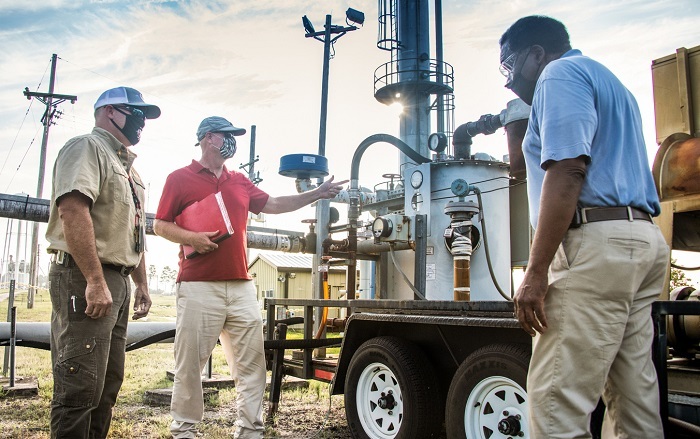 From left, Savannah River Nuclear Solutions mechanic Todd Cockrell, engineer John Bradley, and project manager Joao Cardoso-Neto plan the removal and dismantlement of a high-vacuum soil vapor extraction unit at the Savannah River Site.
AIKEN, S.C. – A 12-year cleanup campaign conducted by EM at the Savannah River Site (SRS) has ended successfully, removing more than 5,000 pounds of chemical solvents from soil and leading to an annual cost savings of $264,000.
Remediation of the M-Area Inactive Process Sewer Line Operable Unit was completed following a review of recent comprehensive soil sampling results under an agreement with the South Carolina Department of Health and Environmental Control.
“I was pleasantly surprised when we reviewed the latest soil sampling data and pleased to see the solvent levels were much lower than I had expected, far below regulatory requirements,” said John Bradley, an engineer with the environmental compliance and area completion projects division at Savannah River Nuclear Solutions (SRNS), the site’s management and operations contractor.
Bradley said the majority of the solvents were removed through the first phase of the project using a high-vacuum soil vapor extraction system requiring large electric pumps, support facilities, and monitoring equipment. With discontinued system operation and maintenance, SRS will realize an annual savings of $264,000.
“We met all of our cleanup requirements for this highly successful project, another important step towards remediating the environment at SRS,” said Bradley.
The solvents were used during the Cold War to degrease manufactured metal components, including nuclear reactor fuel.
For decades, workers at several buildings within a portion of SRS known as M Area disposed used solvents into an underground process pipeline that led to a pond-like storage basin. Eventually, these pipes began to leak where they joined four manhole access points.
This waste disposal system was used in the 1950s at what was then known as the Savannah River Plant. The site was operated by E. I. Du Pont de Nemours under the management of the U.S. Atomic Energy Commission, and later, DOE.
“It met their needs at the time and served its purpose. Unfortunately, time and nature prevailed, and the drainage system began to degrade,” said Joao Cardoso-Neto, a project manager at SRNS. “We’ve dedicated an extensive array of resources over the years to help return this section of SRS to natural conditions. That’s an important part of our mission here that we take seriously.”
-Contributor: DT Townsend
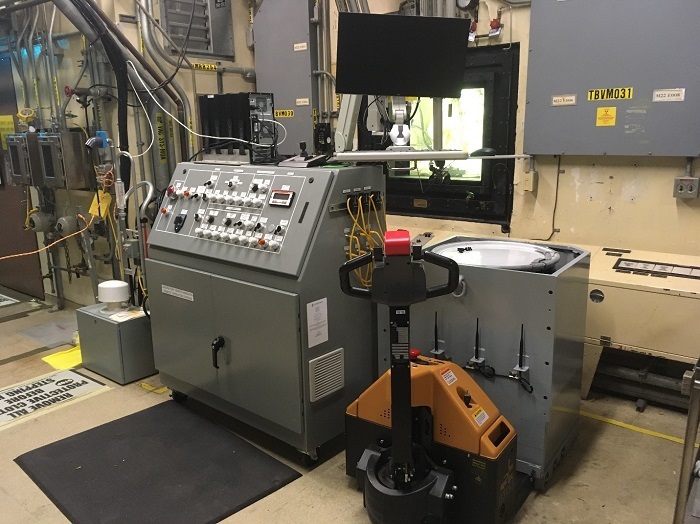 EM and Savannah River Remediation have installed a remote operating station that controls waste-handling components in an adjacent cell at the Defense Waste Processing Facility at the Savannah River Site. The forklift carries a shielded transport container with a drum inside that will hold bagged waste.
AIKEN, S.C. – EM and its liquid waste contractor at the Savannah River Site (SRS) have developed a system that improves protection for workers who handle and dispose of contaminated laboratory waste created at the site’s Defense Waste Processing Facility (DWPF) during the vitrification process.
Historically, the handling and transporting of the lab waste at DWPF was performed by hand, with workers wearing protective clothing. Installation of the new system eliminates the hands-on work performed in the past and greatly reduces the potential for worker exposure to higher levels of radiation. The modifications come as the Salt Waste Processing Facility came online Oct. 5. The facility will process radioactive materials at a rate eight times faster than recent waste treatment operations at SRS.
To create the new worker protections, staff from contractor Savannah River Remediation (SRR) installed remote-control equipment at the DWPF lab and made other renovations that will improve the lab’s waste handling and transporting systems.
SRR operates DWPF, where high-level radioactive waste is being turned into glass for safe, long-term disposal through the vitrification process.
The waste comes from the lab’s sampling and analytical cells, where technicians prepare samples for testing.
Sam Travaglini, an SRR system engineer, said the new system further demonstrates SRR’s dedication to its core values of safety and continuous improvement.
“This system incorporates engineered controls to enable workers to move higher dose rate items from a distance using remote manipulator arms,” Travaglini said. “With increased shielding and remote handling, we improve the level of protection for our workers.”
The waste is remotely placed into bags first and then scanned for radiation levels. A robotic arm will place the contaminated waste into a modified 55-gallon drum and, finally, into a larger container that can hold three drums. The container is then transported to an approved on-site disposal area.
Jim Folk, EM’s assistant manager for waste disposition at SRS, said the installation of remote-controlled equipment is another way that systems are being improved to increase safety.
“Protecting the health of our workers, the public, and the environment is always our top priority,” Folk said. “Making these changes will help keep workers even safer.”
-Contributor: Jim Beasley
AIKEN, S.C. – Innovative equipment known as “bubblers” have been improving liquid waste operations at EM’s Savannah River Site (SRS) for the last decade and will aid in the future operations of the Salt Waste Processing Facility (SWPF) — an EM 2020 priority.
Bubblers are used in the melter, the key equipment at the center of the Defense Waste Processing Facility (DWPF), the site’s vitrification plant operated by EM and SRS liquid waste contractor Savannah River Remediation (SRR). The bubblers improve the heating and melting steps of the vitrification process.
A mixture of high-level sludge waste, glass frit, and water is sent to the melter and heated to 2,100 degrees Fahrenheit in a continuous feeding and pouring operation. The molten-waste mixture is poured into stainless-steel canisters where it hardens, creating a glass waste form — the end product of vitrification.
In September 2010, EM and SRR retrofitted the DWPF melter to accommodate the installation of four melter agitation bubblers. The bubblers were installed to achieve faster waste processing throughout the SRS liquid waste facilities, a significant preparation for SWPF, EM’s facility to process the majority of the remaining radioactive liquid waste at SRS.
SRR subcontractor Atkins developed, designed, and fabricated the melter bubbler technology.
 |
|
Innovative equipment known as bubblers are used to improve the vitrification process at the Savannah River Site’s Defense Waste Processing Facility |
The bubblers agitate the molten glass pool by deploying bubbles near the bottom of the melter using argon gas. The rising bubbles effectively agitate the melt pool. This agitation creates more convection and mixing within the melt pool, increasing the heat transfer to the melt pool cold cap. The cold cap is the layer of unmelted feed floating on top of the melt pool, similar to ice floating on top of water. This rise in heat transfer increases melter throughput, allowing it to pour more canisters of vitrified waste more frequently.
SRR Chief Operating Officer and Deputy Project Manager Mark Schmitz said the bubbler technology has proven to be a positive development for efficient melter operation at DWPF.
“The liquid waste facilities work as an integrated system, and this system will soon include a new major player, the Salt Waste Processing Facility,” Schmitz said. “When one facility is operating efficiently, such as the Defense Waste Processing Facility, the whole system runs well. This reliable integration will be key in ensuring efficient Salt Waste Processing Facility operations.”
-Contributor: Colleen Hart
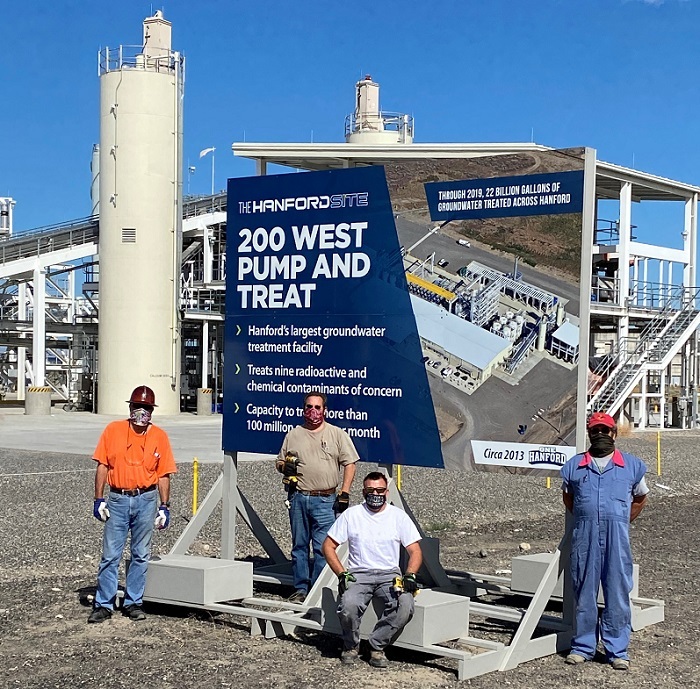 From left, Hanford Site carpenters Carl McLaughlin, Rick Russert, Mike Finney, and Doug MacDonald pause for a photo after installing one of 15 landmark signs commemorating cleanup projects across the 580-square-mile site that produced approximately two-thirds of the plutonium for the national security mission from the Manhattan Project through the late 1980s.
RICHLAND, Wash. – The posts are up, the paint is dry, and the signs showing Hanford Site cleanup successes are available for viewing.
EM Richland Operations Office contractor Mission Support Alliance (MSA) recently finished installing temporary landmark signs at several locations on the 580-square-mile site. The 15 double-sided signs are 8 feet tall and 12 feet wide and includes key information about the facility or area.
“Often times when you drive by areas that have been cleaned up, it looks like nothing was ever there, and we forget how much effort was put into progressing the cleanup mission,” said Rich Buel, deputy director of the Hanford Office of Communications. “These signs help workers and visitors visualize how far we’ve come in cleanup.”
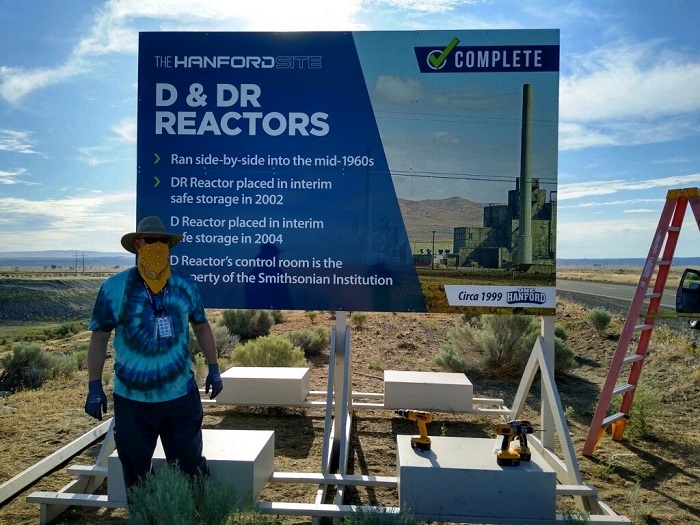 John Doty, sign painter for EM Richland Operations Office contractor Mission Support Alliance, stands in front of a landmark sign commemorating the cleanup of 135 waste sites, removal of 2.5 million tons of contaminated material and “cocooning” of the DR and D reactors. Remediation of the vast infrastructure required to support the national security mission has been the focus of the Hanford Site cleanup over the last 30 years.
The sign project was a collaborative effort by employees of multiple Hanford contractors. Workers built and installed the signs at several of the former plutonium production reactors along the Columbia River; the 200 West Pump and Treat facility; the former site of the Plutonium Finishing Plant, where nearly two-thirds of the nation’s plutonium stockpile was produced; and the Waste Treatment and Immobilization Plant.
-Contributor: Patrick Conrad

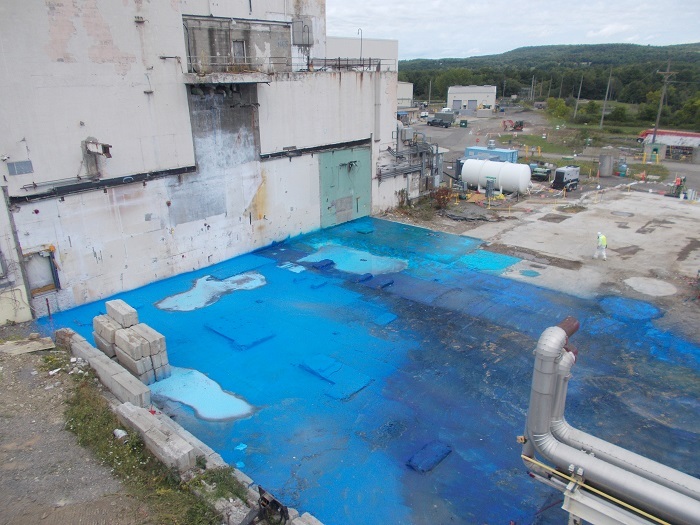 WEST VALLEY, N.Y. – A facility disposition crew at EM’s West Valley Demonstration Project (WVDP) recently encapsulated a concrete foundation slab left following the demolition of a utility building. EM and cleanup contractor CH2M HILL BWXT West Valley encapsulated the slab with a water-based coating that forms an impermeable barrier between hazardous or contaminated materials and the environment. The slab no longer presents an asbestos hazard following this work. This practice protects employees from the hazardous material, safeguards against unintended releases, and is required for any work involving asbestos. The former utility building was demolished in September 2020 and was the last ancillary support building to be removed prior to the demolition of the Main Plant Process Building, scheduled for 2021. EM has removed 67 structures at the site.
-Contributor: Joseph Pillittere
|